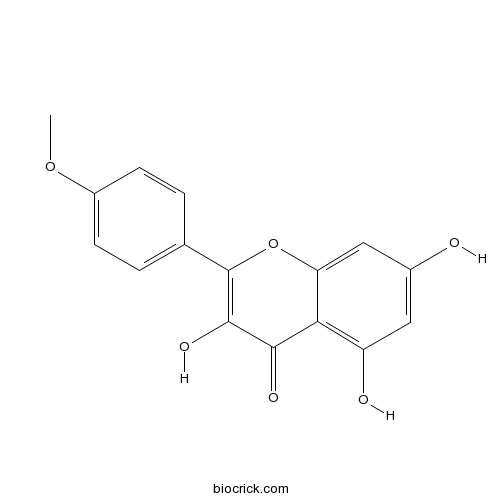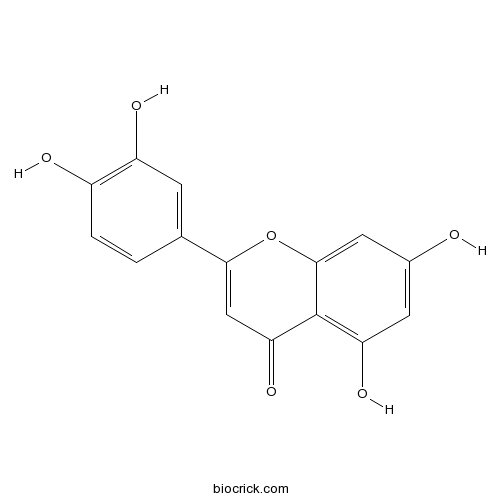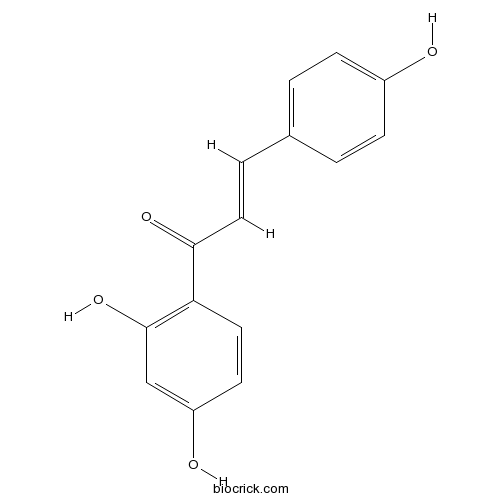Sedum sarmentosum
Sedum sarmentosum
1. The products in our compound library are selected from thousands of unique natural products; 2. It has the characteristics of diverse structure, diverse sources and wide coverage of activities; 3. Provide information on the activity of products from major journals, patents and research reports around the world, providing theoretical direction and research basis for further research and screening; 4. Free combination according to the type, source, target and disease of natural product; 5. The compound powder is placed in a covered tube and then discharged into a 10 x 10 cryostat; 6. Transport in ice pack or dry ice pack. Please store it at -20 °C as soon as possible after receiving the product, and use it as soon as possible after opening.
Natural products/compounds from Sedum sarmentosum
- Cat.No. Product Name CAS Number COA
-
BCN5570
Hyperoside482-36-0
Instructions

-
BCN5598
Kaempferide491-54-3
Instructions

-
BCN5600
Luteolin491-70-3
Instructions

-
BCN5945
Isoliquiritin5041-81-6
Instructions

-
BCN5946
Liquiritigenin578-86-9
Instructions

-
BCN4512
Isoliquiritigenin961-29-5
Instructions

Ameliorative effect of Sedum sarmentosum Bunge extract on Tilapia fatty liver via the PPAR and P53 signaling pathway.[Pubmed: 29855491]
Fatty liver disease is a growing problem in fish aquaculture and there is an urgent need to identify causes and possible remedies. In the present study, the effects of treating fatty liver disease in the Nile tilapia (Oreochromis niloticus Linnaeus, 1758) with an extract derived from a herb, Sedum sarmentosum Bunge (SSB), was investigated. We found that the SSB extract could restore the changes to feed coefficient, immune capacity, and pathological index caused by fatty liver disease, and also prevent apoptosis in hepatocytes. An RNA-seq analysis showed that treatment with SSB extract altered expression of genes in the lipid metabolic process, metabolic process, and oxidation-reduction process. Our results suggest that disorders of the PPAR and p53 signaling pathways may be involved in steatohepatitis development and in the therapeutic mechanism of the SSB extract treatment; these observations shed new light on possible treatment of steatohepatitis.
A novel release kinetics evaluation of Chinese compound medicine: Application of the xCELLigence RTCA system to determine the release characteristics of Sedum sarmentosum compound sustained-release pellets.[Pubmed: 29556137]
None
A Phytochemical Approach to Promotion of Self-renewal in Murine Spermatogonial Stem Cell by Using Sedum Sarmentosum Extract.[Pubmed: 28900261]
Spermatogonial stem cells (SSCs) are the basis of spermatogenesis, which is dependent on the ability to self-renew and differentiation. Controlling self-renewal and differentiation of SSCs could apply to treatment of disease such as male infertility. Recently, in the field of stem cell research, it was demonstrated that effective increase in stem cell activity can be achieved by using growth factors derived from plant extracts. In this study, our aim is to investigate components from natural plant to improve the self-renewal of SSCs. To find the components, germ cells were cultured with comprehensive natural plant extracts, and then the more pure fraction, and finally single compound at different concentrations. As a result, we found 5H-purin-6-amine at 1 µg/mL, originated from Sedum sarmentosum, was a very effective compound induced SSCs proliferation. Our data showed that germ cells cultured with 5H-purin-6-amine could maintain their stable characteristics. Furthermore, transplantation results demonstrated that 5H-purin-6-amine at 1 µg/mL increased the activity of SSCs, indicating the compound could increase true SSC concentration within germ cells to 1.96-fold. These findings would be contributed to improve further reproductive research and treat male infertility by using natural plant extracts.
Anti‑fibrotic effect of Sedum sarmentosum Bunge extract in kidneys via the hedgehog signaling pathway.[Pubmed: 28560403]
Sedum sarmentosum Bunge (SSBE) is a perennial plant widely distributed in Asian countries, and its extract is traditionally used for the treatment of certain inflammatory diseases. Our previous studies demonstrated that SSBE has marked renal anti‑fibrotic effects. However, the underlying molecular mechanisms remain to be fully elucidated. The present study identified that SSBE exerts its inhibitory effect on the myofibroblast phenotype and renal fibrosis via the hedgehog signaling pathway in vivo and in vitro. In rats with unilateral ureteral obstruction (UUO), SSBE administration reduced kidney injury and alleviated interstitial fibrosis by decreasing the levels of transforming growth factor (TGF)‑β1 and its receptor, and inhibiting excessive accumulation of extracellular matrix (ECM) components, including type I and III collagens. In addition, SSBE suppressed the expression of proliferating cell nuclear antigen, and this anti‑proliferative activity was associated with downregulation of hedgehog signaling activity in SSBE‑treated UUO kidneys. In cultured renal tubular epithelial cells (RTECs), recombinant TGF‑β1 activated hedgehog signaling, and resulted in induction of the myofibroblast phenotype. SSBE treatment inhibited the activation of hedgehog signaling and partially reversed the fibrotic phenotype in TGF‑β1‑treated RTECs. Similarly, aristolochic acid‑mediated upregulated activity of hedgehog signaling was reduced by SSBE treatment, and thereby led to the abolishment of excessive ECM accumulation. Therefore, these findings suggested that SSBE attenuates the myofibroblast phenotype and renal fibrosis via suppressing the hedgehog signaling pathway, and may facilitate the development of treatments for kidney fibrosis.
Two new megastigmanes from Chinese traditional medicinal plant Sedum sarmentosum.[Pubmed: 28152607]
To discover new bioactive compounds from nature plants, a primary screening of traditional Chinese medicines had been taken. The screening results showed that a EtOAc extract of Sedum sarmentosum displayed a certain degree of cytotoxic activity and bioassay-directed isolation of EtOAc extract gave two new megastigmanes, (6S,9R)-2-hydroxy-4-(2,6,6-trimethyl-4-oxo-cyclohex-2-enyl)-butyric acid (1) and (6S,9R)-2-hydroxy-4-(2,6,6-trimethyl-4-oxo-cyclohex-2-enyl)-butyric acid methyl ester (2) together with seven known flavonoids. The chemical structures of 1 and 2 were elucidated on the basis of detailed 1D, 2D NMR and MS data. When tested against HepG2 and Hep3B hepatocellular carcinoma cell lines, compounds 1-9 showed weak anti-HCC activity. In addition, in vitro antioxidant activities of 1-9 were evaluated by ABTS radical cation-scavenging assay. 1 and 2 exhibited weak activity with per micromoles equivalent to 0.039 and 0.042 μM of Trolox, respectively. The flavonoid component, quercetin (9) showed the highest antioxidant activities with per micromoles equivalent 0.67 μM of Trolox.
Botrytis pyriformis sp. nov., a novel and likely saprophytic species of Botrytis.[Pubmed: 27153884]
A novel species of Botrytis from Sedum sarmentosum was described based on morphology and analyses of DNA sequences of nuc rDNA ITS regions and three nuclear genes (G3PDH, HSP60, RPB2). Meanwhile pathogenicity in 32 plant species, response to temperature for growth and conidial germination for the species were determined. The Botrytis species was named Botrytis pyriformis sp. nov. It was characterized by formation of grayish mycelia, brownish conidia and melanized sclerotia on PDA. The conidia are pear-shaped, melanized and covered with abundant villiform appendages on the conidial surface. Comparison of the ITS sequences confirmed its placement in the genus Botrytis Phylogenetic analysis based on DNA sequences of G3PDH, HSP60 and RPB2 genes indicated that B. pyriformis and other 30 Botrytis species form a monophyletic clade, which was further divided into three subclades. Subclade I comprised B. pyriformis alone, whereas subclades II and III comprised six and 24 Botrytis species, respectively. Botrytis pyriformis could not infect 32 plant species including S. sarmentosum, possibly due to deficiency in formation of infection cushions. This study presents a formal description and illustrations for B. pyriformis and provides experimental evidence, indicating that B. pyriformis might be a saprophytic species.
Sedum sarmentosum Bunge extract induces apoptosis and inhibits proliferation in pancreatic cancer cells via the hedgehog signaling pathway.[Pubmed: 26987050]
Sedum sarmentosum Bunge, a traditional Chinese herbal medicine, has a wide range of clinical applications including antibiosis, anti-inflammation and anti-oxidation. In the present study, we identified that its extract (SSBE) exerts pancreatic anticancer activity in vitro and in vivo. In the cultured pancreatic cancer PANC-1 cell line, SSBE inhibited cell growth in a concentration-dependent manner, and it was accompanied by the downregulated expression of proliferating cell nuclear antigen (PCNA). In addition, SSBE treatment also increased cellular apoptosis in a mitochondrial-dependent manner. Moreover, SSBE induced p53 expression, reduced c-Myc expression, and inhibited epithelial-mesenchymal transition (EMT). The antiproliferative activity of SSBE in the pancreatic cancer cells was found to be closely related to cell cycle arrest at the G2/M phase by upregulating p21(Waf1/CIP1) expression. Further study showed that this inhibitory effect of SSBE was through downregulation of the activity of the proliferation-related Hedgehog signaling pathway. Exogenous recombinant protein Shh was used to activate Hedgehog signaling, thereby resulting in the abolishment of the SSBE-mediated inhibition of pancreatic cancer cell growth. In animal xenograft models of pancreatic cancer, activated Hedgehog signaling was also observed compared with the vehicle controls, but was reduced by SSBE administration. As a result, SSBE suppressed the growth of pancreatic tumors. Thus, these findings demonstrate that SSBE has therapeutic potential for pancreatic cancer, and this anticancer effect in pancreatic cancer cells is associated with inhibition of the Hedgehog signaling pathway.
[Study on effect of total flavanones of Sedum sarmentosum on apoptosis of hepatic stellate cells and its mechanism].[Pubmed: 26790306]
To study the effect of total flavanones of Sedum sarmentosum (SSTF) on the apoptosis of rat hepatic stellate cells (HSC-T6) and its mechanism.


